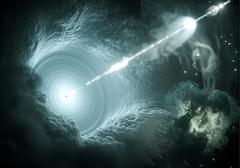About
On this page you can learn more about what the International Cosmic Day is, when and where it takes place, who organizes it and what you can do on that day.
What is the ICD?
International Cosmic Day is an annual event that brings together young people, teachers, and scientists from around the world to immerse themselves in the world of astroparticle physics and create a full day around the theme of cosmic rays. Together we will explore fundamental research questions. There will be joint meetings for discussions, creative competitions, experiments and much more. You decide how you want to organize your event and we accompany you and are available for questions!
For more detailed information about the event, see our contribution to the 35th International Cosmic Ray Conference:
Who organizes the ICD?
The ICD is organized by a group of people from DESY lead by Carolin Gnebner together with IPPOG and many national networks and partners.
Who participates?
You! We invite groups of young people in different places around the world to participate in ICD. Regardless of whether your event is at a school, university, or other institution: Ask a teacher or scientist at your location to register the group.
When?
The ICD has been held once a year since 2012, usually in November.
Where?
The ICD takes place entirely online. We provide the tools for communication and organize, for example, video calls in which you can exchange and network with other groups worldwide.
How to participate?
Prior registration is required to participate in the ICD. Corresponding information can be found under Registration.
You do not need an Indico account to register. You only need one if you want to change your registration at a later date.
If more than one student would like to participate in the day under the direction of one teacher, we ask only the teacher to register the group. Participating students will be registered individually at the sites.
Participation also requires access to a cosmic ray experiment capable of performing one of the measurements described in the program.
We organize the communication between the different participants, but not the individual program or participation. Under Activities you will find our collections of ideas and activities that we propose for this year's ICD.

You may wonder what motivates us to hold an ICD every year. It is you! Young people who are interested in astroparticle physics and want to learn more.
Here you can learn about the physics behind the ICD:
The Physics behind the ICD
The relatively young research field of astroparticle physics has developed dynamically in recent years. It combines particle physics (description of the interactions of elementary particles) with astrophysics (description of the largest structures in the universe) and with cosmology (study of the history of the universe).
One of the most interesting topics in astroparticle physics is the attempt to understand the mechanisms of acceleration of cosmic ray particles to very high energies, much higher than accelerators on Earth can reach. Only the most massive objects in the cosmos provide the necessary conditions for this: supernovae with their explosion shock waves, magnetic fields of rapidly rotating neutron stars, colliding galaxies, or energetic black hole nuclei of active galaxies.

An artist's drawing of a particle jet emanating from a black hole at the center of a blazar.
Credit: DESY, Science Communication Lab
Some active galaxies, called blazars, develop narrow twin jets of light and elementary particles, one of which points toward Earth and is emitted from the poles along the black hole's rotation axis. The image above shows one of these two jets. They are powerful cosmic engines that accelerate high-energy cosmic rays. In addition, blazars accelerate protons and pions are produced, which in turn produce neutrinos and gamma rays. Neutrinos are uncharged particles that are unaffected by even the strongest magnetic field. Because they rarely interact with matter and have almost no mass, neutrinos travel almost undisturbed from their accelerators, giving scientists an almost direct clue to their source. With the help of neutrinos and gamma rays, we can point to cosmic ray accelerators.
There are many scientific experiments with huge detectors aimed at unraveling the mysteries of cosmic rays. If you are interested, have a look at the websites of the following experiments and collaborations: ANTARES, Auger, Fermi, HAWC, H.E.S.S., IceCube, KM3NeT, MAGIC, Telescope Array, VERITAS, Cherenkov Telescope Array.
